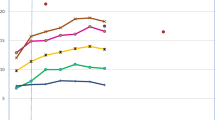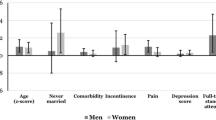Abstract
Background
Falls are a major cause of disability, morbidity, institutionalization, and mortality in older adults.
Objectives
The purpose of the study was to examine the risk factors for falls among Mexican older adults aged 60 years and older.
Methods
This study included 6247 participants and their spouse or partner aged 60 years and older from the Mexican Health and Aging Study, an ongoing longitudinal study (2001–2012) conducted in Mexico. Measures included socio-demographics, falls, physical activity, comorbid conditions, pain, vertigo, vision and hearing impairments, urinary incontinence, lower extremity functional limitation, activities of daily living (ADLs), cognitive function, and depressive symptoms.
Results
Mean age was 69.6 years (standard error = 0.18) and 51.8% were female. Forty percent reported one or more falls at baseline. Older age, being female, obesity, arthritis, fractures, stroke, suffering pain, vertigo, lower extremity functional limitations, physical activity, depressive symptoms, urinary incontinence, and ADL disability were significant factors associated with one or more falls over time.
Discussion
Early detection and treatment of the risk factors for falls in this population will help improve the quality of life and reduce medical complications and health care costs.

Similar content being viewed by others
Data availability
The datasets generated during and/or analyzed during the current study are available in http://www.mhasweb.org/.
References
Falls—fact sheet (2018). http://www.who.int/mediacentre/factsheets/fs344/en/
Centers for Disease Control and Prevention (2018) Important facts about falls. https://www.cdc.gov/homeandrecreationalsafety/falls/adultfalls.html. Accessed 16 March 2018
Bergen G, Stevens M, Burns ER (2016) Falls and fall injuries among adults aged ≥ 65 years—United States, 2014. MMWR Morb Mortal Wkly Rep 65:993–998
Murphy SL, Xu J, Kochanek KD et al (2017) Deaths: final data for 2015, vol 66. National Center for Health Statistics, Hyattsville
Estrella-Castillo DF, Euán-Paz A, Pinto-Loría ML et al (2011) Alteraciones del equilibrio como predictoras de caídas en una muestra de adultos mayores de Mérida Yucatán, México. Rehabilitación 45:7
World Health Organization (2015) World report on aging and health. World Health Organization, Luxembourg
Becker C, Woo J, Todd C (2018) Falls. In: Michel J-P, Beattie BL, Martin FC, Walston JD (eds) Oxford textbook of geriatric medicine, 3rd edn. Oxford University Press, Oxford, pp 373–382
Deandrea S, Lucenteforte E, Bravi F et al (2010) Risk factors for falls in community-dwelling older people: a systematic review and meta-analysis. Epidemiology 21:658–668. https://doi.org/10.1097/EDE.0b013e3181e89905
Lusardi MM, Fritz S, Middleton A et al (2017) Determining risk of falls in community dwelling older adults: a systematic review and meta-analysis using posttest probability. J Geriatr Phys Ther 40:1–36
Reyes-Ortiz CA, Al Snih S, Loera J et al (2004) Risk factors for falling in older Mexican Americans. Ethn Dis 14:417–422
Encuesta Nacional de Salud y Nutrición 2012 (2013) Resultados Nnacionales, Segunda Edicion, Mexico
Aranda M, López-Ortega M, Robledo L (2015) Prevalence and determinants of falls among Older Mexicans: findings from the Mexican National Health and Nutrition Survey. In: Vega W, Markides K, Angel J, Torres-Gil F (eds) Challenges of Latino aging in the Americas. Springer, Cham, pp 171–188
France CB, Rietjens Judith AC, Burdorf A et al (2017) A prospective study on the variation in falling and fall risk among community-dwelling older citizens in 12 European countries. BMJ Open 7:e015827
Gale CR, Cooper C, Sayer AA (2016) Prevalence and risk factors for falls in older men and women: the English Longitudinal Study of Ageing. Age Ageing 45:89–794
Verma SK, Willetts JL, Corns HL et al (2016) Falls and fall-related injuries among community-dwelling adults in the United States. PLoS ONE 11:e0150939. https://doi.org/10.1371/journal.pone.0150939
Demographic transition, demographic bonus and ageing in Mexico. Prepared for United Nations Expert Group Meeting on Social and Economic Implications of Changing Population Age Structures (Mexico City, Mexico: Population Division, Department of Economic and Social Affairs, United Nations, 2005) (2005). http://www.un.org/esa/population/meetings/Proceedings_EGM_Mex_2005/partida.pdf
MHAS 2012-Sample Design (2012). http://mhasweb.org/Resources/DOCUMENTS/2012/Methodological_Document_2012%E2%80%93SEC.pdf
Wong R, Michaels-Obregon A, Palloni A (2017) Cohort profile: the Mexican health and aging study (MHAS). Int J Epidemiol 46:e2. https://doi.org/10.1093/ije/dyu263
Nicklett EJ, Taylor RJ (2014) Racial/Ethnic predictors of falls among older adults: the health and retirement study. J Aging Health 26:1060–1075. https://doi.org/10.1177/0898264314541698
Reyes-Ortiz CA, Al Snih S, Markides KS (2005) Falls among elderly persons in Latin America and the Caribbean and among elderly Mexican-Americans. Rev Panam Salud Publica 17:362–369
Sun DQ, Huang J, Varadhan R et al (2016) Race and fall risk: data from the National Health and Aging Trends Study (NHATS). Age Ageing 45:8
http://www.nhlbi.nih.gov/health/public/heart/obesity/lose_wt/bmi_dis.htm
MHAS Questionnaire (2001) http://mhasweb.org/Resources/DOCUMENTS/2001/Core_Questionnaire_2001.pdf
Diaz de Leon Gonzalez E, Gutierrez Hermosillo H, Martinez Beltran JA et al (2016) Validation of the FRAIL scale in Mexican elderly: results from the Mexican Health and Aging Study. Aging Clin Exp Res 28:901–908. https://doi.org/10.1007/s40520-015-0497-y
Albala C, Lebrao ML, Leon Diaz EM et al (2005) [The Health, Well-Being, and Aging (“SABE”) survey: methodology applied and profile of the study population]. Rev Panam Salud Publica 17:307–322
Valderrama-Hinds LM, Al Snih S, Rodriguez MA et al (2017) Association of arthritis and vitamin D insufficiency with physical disability in Mexican older adults: findings from the Mexican Health and Aging Study. Rheumatol Int 37:607–616. https://doi.org/10.1007/s00296-016-3622-0
Gerst K, Michaels-Obregon A, Wong R (2011) The impact of physical activity on disability incidence among older adults in Mexico and the United States. J Aging Res 2011:420714. https://doi.org/10.4061/2011/420714
Monserud MA, Wong R (2015) Depressive symptoms among older Mexicans: the role of widowhood, gender, and social integration. Res Aging 37:856–886. https://doi.org/10.1177/0164027514568104
Diggle P, Heagerty P, Liang KY et al (2013) Generalized linear mixed models for longitudinal data. In: Analysis of longitudinal data, 2nd edn. Oxford University Press, Oxford, pp 126–137
Himes CL, Reynolds SL (2012) Effect of obesity on falls, injury, and disability. J Am Geriatr Soc 60:124–129. https://doi.org/10.1111/j.1532-5415.2011.03767.x
Stenhagen M, Ekstrom H, Nordell E et al (2013) Falls in the general elderly population: a 3- and 6-year prospective study of risk factors using data from the longitudinal population study ‘Good ageing in Skane’. BMC Geriatr 13:81. https://doi.org/10.1186/1471-2318-13-81
Mackenzie L, Byles J, D’Este C (2006) Validation of self-reported fall events in intervention studies. Clin Rehabil 20:331–339. https://doi.org/10.1191/0269215506cr947oa
Hansen H, Schafer I, Schon G et al (2014) Agreement between self-reported and general practitioner-reported chronic conditions among multimorbid patients in primary care—results of the MultiCare Cohort Study. BMC Fam Pract 15:39. https://doi.org/10.1186/1471-2296-15-39
Sanders KM, Stuart AL, Scott D et al (2015) Validity of 12-month falls recall in community-dwelling older women participating in a clinical trial. Int J Endocrinol 2015:210527. https://doi.org/10.1155/2015/210527
Panel on Prevention of Falls in Older Persons, American Geriatrics Society and British Geriatrics Society (2011) Summary of the updated American Geriatrics Society/British Geriatrics Society Clinical Practice guideline for prevention of falls in older adults. J Am Geriatr Soc 59 (1):148–157
Tricco AC, Thomas SM, Veroniki AA et al (2017) Comparisons of interventions for preventing falls in older adults: a systematic review and meta-analysis. JAMA 318:1687–1699. https://doi.org/10.1001/jama.2017.15006
Acknowledgements
This study was supported by the National Institutes of Health/National Institute on Aging (R01-AG018016, R.W. [PI]), INEGI in Mexico and by the University of Texas Medical Branch (UTMB) Sealy Center on Aging and the Pepper Center (P30-AG024832, E.V. [PI]). Dr. Valderrama-Hinds was a visiting scholar in the WHO/PAHO Collaborating Center on Aging and Health at UTMB during this study. The study sponsors had no role in the study design, analysis, or interpretation of the data. Study sponsors did not have any role in the writing of the article or the submission to a journal. The authors acknowledge the assistance of Sarah Toombs Smith, PhD, ELS, in article preparation. Dr. Toombs Smith received no compensation for this effort beyond her salary at the UTMB Sealy Center on Aging.
Author information
Authors and Affiliations
Corresponding author
Ethics declarations
Conflict of interest
The authors declare that they have no conflicts of interest.
Ethical approval
The MHAS study was approved by the Institutional Review Boards or Ethics Committees of the University of Texas Medical Branch (in the United States) and the Instituto Nacional de Estadistica y Geografia (INEGI) and the Instituto Nacional de Salud Pública (INSP) (in Mexico); and have been performed in accordance with the ethical standards as laid down in the 1964 Declaration of Helsinki.
Informed consent
Oral informed consent was obtained from all individual participants included in the study.
Rights and permissions
About this article
Cite this article
Valderrama-Hinds, L.M., Al Snih, S., Chen, Nw. et al. Falls in Mexican older adults aged 60 years and older. Aging Clin Exp Res 30, 1345–1351 (2018). https://doi.org/10.1007/s40520-018-0950-9
Received:
Accepted:
Published:
Issue Date:
DOI: https://doi.org/10.1007/s40520-018-0950-9




